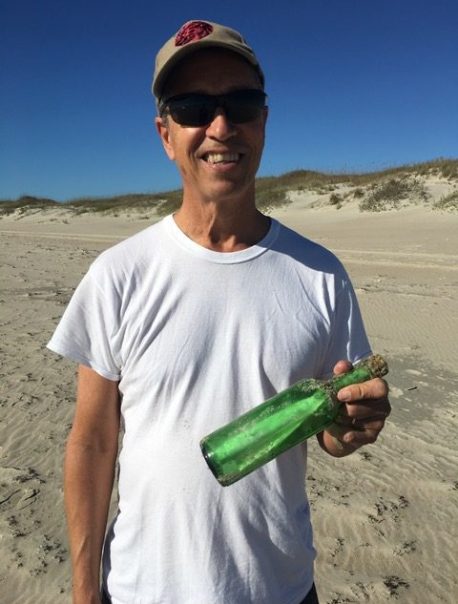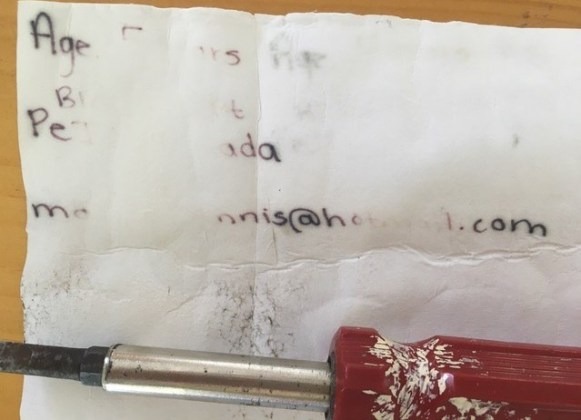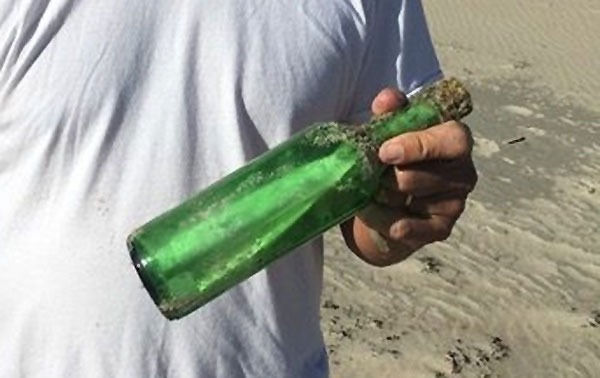
Flotsam bottles containing messages are one of those treasures that beachcombers dream of finding.
Roy and Ann Huntley of Raleigh, who have a house on Ocracoke and visit frequently, got a longtime wish when they found such a bottle on the beach last November.
“I mean, I was pretty excited,” Roy said. “I never found a message in a bottle before. It had a big ole piece of paper in it and I got pretty excited that we were gonna rescue somebody somewhere.”
The Huntleys took the 12-ounce green bottle home and tried to remove the screw top. But that didn’t work and though they didn’t want to, they broke the bottle to retrieve the message.
Condensation incursion had erased about three fourths of the message, Roy said.
But they persevered and figured out “Canada,” a town starting with “Br” and ending in “t,” and then deciphered “PEI” for Prince Edward Island.
Roy and Ann knew P.E.I. was small from their trip there in 1986 when they’d visited while camping in a Volkswagen van.
Ann suggested they try another tack—contact the local media.
They contacted “The Guardian,” a newspaper on P.E.I., and reporter Alison Jenkins contacted the couple.
The Huntleys sent her photos and after the story ran the community weighed in with clues. The day after the story ran the author of the message, a little girl Dani McCormack and her family were found, said Jenkins in an email.
Dani is now eight but was five when she threw the bottle into the water three years ago during a boating trip off the Naufrage Harbor, according to Jenkins’ story.
“We thought that bottle had been around for a few months,” Roy said.

If someone threw a message in a bottle into the ocean off the coast of maritime Canada and three years later it turned up on an Ocracoke beach, what route would it have taken?
Viewing graphics of Atlantic Ocean currents show it could have gone a variety of ways—over toward England, down along Europe and Africa and back across the Atlantic to pick up the Gulf Stream and a ride north to Ocracoke.
Or, it could have attached to currents that go up and down along the Continental Shelf along the East Coast in the mid-Atlantic and south Atlantic bights, said Dr. Michael Muglia, an oceanographer with the Coastal Studies Institute in Wanchese.
Cape Hatteras is the dividing line of water going north and south, he said.
“If we get a north blow, eventually that Hatteras flow will make its way to Ocracoke,” he said.
Soon after learning about Dani, the Huntleys called the girl.
“I asked her how did she get the idea (to throw the bottle in the ocean) and she said, ‘My mom made me do it,’” Ann said.
Ann learned that Dani, who’s in third grade, loves to read.
“So, we sent her two of my favorite books,” Ann said. “’Taffy of Torpedo Junction’ and ‘Misty of Chincoteague’ just to give her a flavor of our beach.”
Oh, and a Cape Hatteras National Seashore map of Ocracoke.
So, Roy and Ann might not have rescued someone from a desert island, but they added to the friendship between the United States and Canada.





Cool story! And goes to show you: always use a lead pencil when writing messages in a bottle. They won’t fade for 100-200 years. Remember that for the next time you’re shipwrecked and needing rescue!